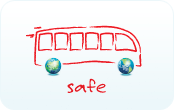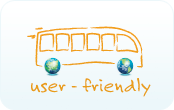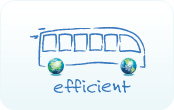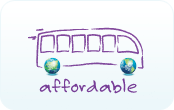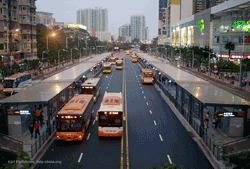 |
The Wall Street Journal highlights the growing popularity of Bus Rapid Transit (BRT) system around the world, describing BRT as a modern transit system with the flexibility of buses, and the speed, comfort and reliability of rail.
With its dedicated lanes, accommodating service areas, technologically advanced stations and GPS tracking systems, BRT offers a comprehensive mass transit service at a fraction of typical costs. In fact, for the amount of capital it takes to build a single rail line, localities can build multiple BRT lines.
The Institute for Transportation and Development Policy (ITDP) executive director, Walter Hook, confirms BRT’s potential in cities where funding is scarce. “BRT will be an important option for transit systems in the future, especially in cities where transit demand is high and budgets are tight,” Hook says.
|
|
Due to its flexible service and low capital investments, BRT has found success around the world. The world’s most successful BRT, the “RIT” in Curitiba, Brazil, serves over 2 million passengers a day, transforming the city’s traffic. Similarly, the systems in Bogota and Teheran respectively serve 1.7 million and 1.4 million passengers daily by drawing commuters away from private vehicles and on to mass transit. Overall, last year saw the completion of 16 new BRT services, and now 49 new systems are also on the way.
”Today the Guangzhou BRT services over 800,000 riders daily and was built for about one-tenth the cost of the metro, with an average of one bus passing every 10 seconds in peak hours, it carries more passengers in a single direction than just about every metro lines in all of China, and more than triple any other BRT system in Asia. The system has resulted in 30 percent higher bus speeds, and reduced congestion along the corridor at the same time as vehicle volumes have increased, primarily due to the solving of severe problems of congestion at bus stops, and intersection signal improvements.” explained ITDP director of marketing and communications, Dani Simons
The Guangzhou BRT was able to eliminate 50,000 tons of carbon dioxide in its first year, mostly due in part to residents choosing BRT over private vehicles and taxis, in addition to help cut congestion and improve traffic flow.
In addition to the global enthusiasm for BRT is growing popularity in the U.S. There are currently five cities in the U.S., including Los Angeles and Cleveland, which use BRT as a part of their public transit system and eight to ten new BRT systems under consideration.
Read More on CityFix
See the video “Moving Beyond Automobile: Bus Rapid Transit”
|
